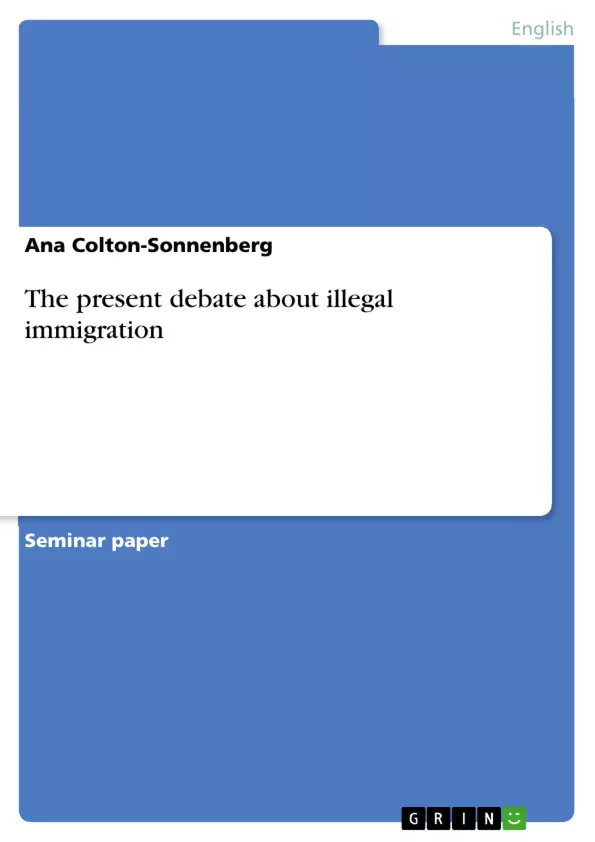As former U.S. President John F. Kennedy indicates in his posthumously published and recently re-edited essay A Nation of Immigrants, all citizens of the United States are immigrants or descendants of immigrants. Therefore, according to the author, immigration policy should suit their needs in order to ensure the well-being of a country which depends on “the contribution of immigrants […] in every aspect of [its] national life.” However, with 37.4 million foreign-born residents in the United States in 2006 , of which 9.1 million have obtained legal permanent resident status since 1997 (1,266,264 in 2006 only) and an estimated 11.6 million are unauthorized migrants , immigration has become a highly controversial subject. Fuelled by the 9/11 attacks and a growing xenophobia in the United States, protest against legal and illegal immigration is increasing, forcing politicians to take action. Although the U.S. economy depends largely on immigrant labour, immigration policy is becoming tougher than ever.
This paper deals with the latest legal efforts to control illegal immigration: the 2005 Border Protection, Anti-terrorism, and Illegal Immigration Control Act, House of Representatives Bill 4437 and the 2006 Comprehensive Immigration Reform Act, Senate Bill 2611 and the reactions they caused among Americans. In order to illustrate the momentousness of the current debate about unauthorized migration, I will start with an overview of the most important facts and figures including a definition of the notion ‘illegal/ unauthorized (im)migrant’, the countries of origin and distribution of illegal immigrants and their impact on the U.S. economy. This will be followed by a discussion of the H.R.4437 and S.2611 bills and the conclusion to this paper.
Inhaltsverzeichnis (Table of Contents)
- Introduction
- Illegal Immigrants in the U.S.: Facts and Figures
- Who is an Illegal Immigrant?
- Countries of Origin and Distribution
- The Economics of Illegal Immigration
- Latest Attempts to Control Immigration: H.R.4437 and S.2611
- H.R.4437 – Border Protection, Antiterrorism, and Illegal Immigration Control Act
- Reactions to H.R.4437 and S.2611
- Conclusion
Zielsetzung und Themenschwerpunkte (Objectives and Key Themes)
This paper examines the current debate about illegal immigration in the United States, focusing on the latest legislative attempts to control unauthorized migration. It aims to provide a comprehensive overview of the issue, including factual information, key arguments, and reactions to proposed legislation.
- The definition and characteristics of unauthorized immigration
- The demographics and economic impact of illegal immigrants in the U.S.
- The content and reception of two key immigration bills: H.R. 4437 and S. 2611
- The political and social context of the ongoing debate about illegal immigration
- The historical perspective of immigration in the United States.
Zusammenfassung der Kapitel (Chapter Summaries)
The introduction sets the context for the paper by highlighting the significance of immigration in American history and the growing controversy surrounding illegal immigration. It establishes the focus on recent legislative attempts to control unauthorized migration and outlines the paper's structure.
The second chapter provides a comprehensive overview of the facts and figures related to illegal immigration in the United States. It defines the term "unauthorized immigrant," examines the countries of origin and distribution of illegal immigrants, and discusses the economic impact of their presence.
Chapter three focuses on the two major pieces of legislation introduced in 2005 and 2006 to control illegal immigration: the Border Protection, Antiterrorism, and Illegal Immigration Control Act (H.R. 4437) and the Comprehensive Immigration Reform Act (S. 2611). It examines the key provisions of these bills and explores the reactions they generated among different segments of American society.
Schlüsselwörter (Keywords)
The main keywords and focus topics of this paper include: illegal immigration, unauthorized immigration, H.R. 4437, S. 2611, border control, antiterrorism, immigration reform, xenophobia, economic impact, social consequences, political debate, American history, and immigrant labor.
- Arbeit zitieren
- Ana Colton-Sonnenberg (Autor:in), 2008, The present debate about illegal immigration, München, GRIN Verlag, https://www.grin.com/document/90903



